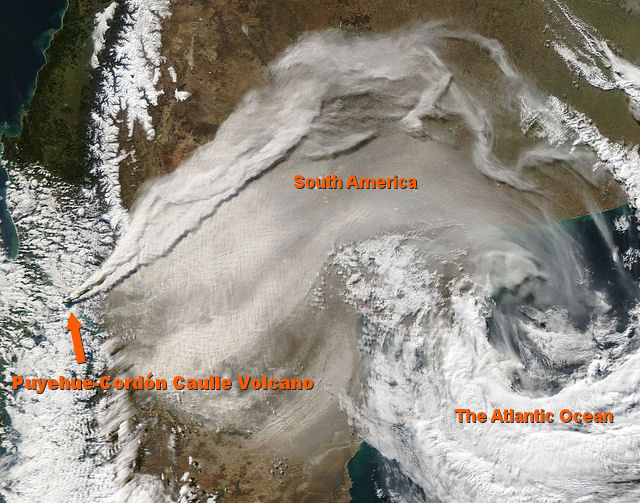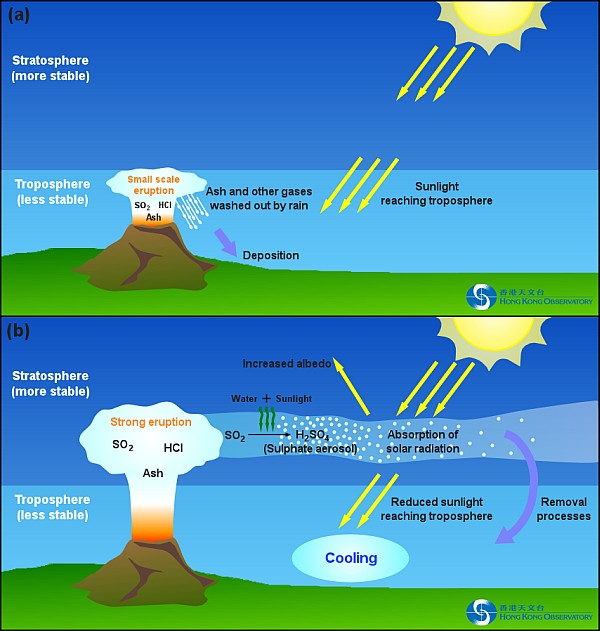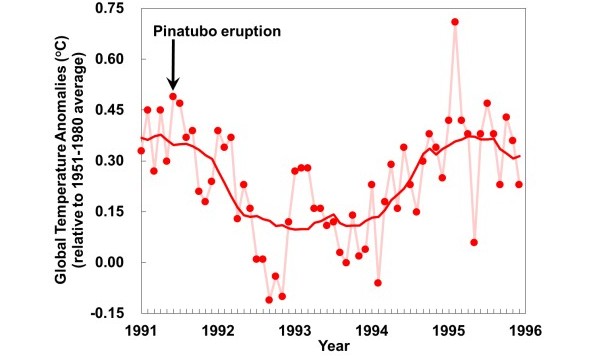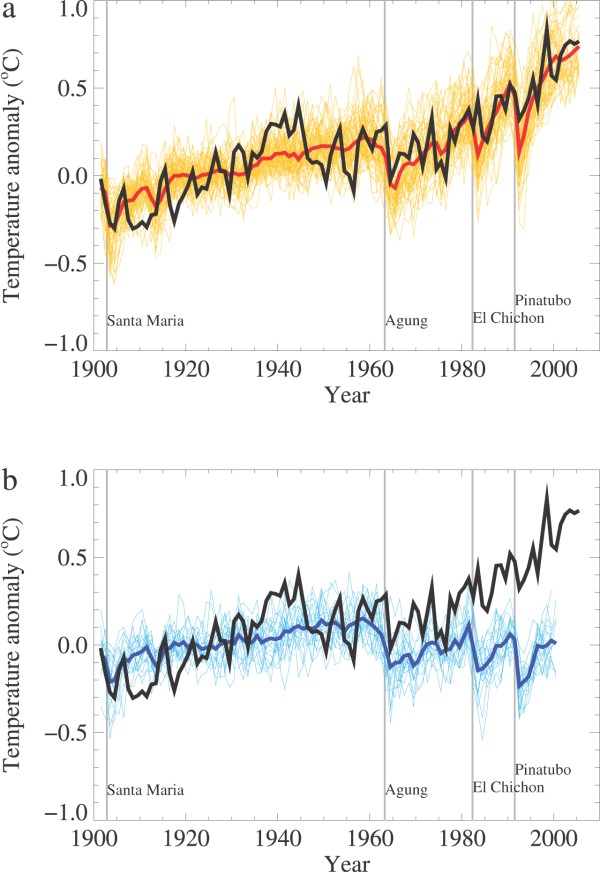Volcanoes, weather and climate
Volcanoes, weather and climate
SLEE Tsz-cheung and KOK Mang-hin
August 2011
Volcanic eruption is one of the most stunning natural phenomena on the Earth. Although images of the mushroom ash clouds and volcanic lightning are spectacular and impressive, volcanic eruptions do have significant impacts on humans. Volcanic ash and lahars (i.e. mudflow from a volcano) can pose safety threats to people living on the ground and ash clouds can seriously disrupt traffic in the air. Recent examples include the volcanic eruptions in Iceland in 2010 and in Chile in June 2011.

Figure 1 The MODIS instrument on NASA's Aqua satellite captured this visible image of the ash plume from the eruption of Chile's Puyehue-Cordón Caulle volcano on June 12, 2011 at 18:05 UTC. The ash plume was blowing to the northeast and getting drawn into a low pressure area over the Atlantic Ocean. (Image Credit: NASA Goddard/MODIS Rapid Response, Jeff Schmaltz/Text: NASA/Rob Gutro,)
Volcanic activities can also affect weather and climate. Large amount of gases and particles can be released to the atmosphere during eruptions, thereby affecting short term weather and long term climate. Generally speaking, the influence of volcanic eruptions on weather or climate depends very much on the severity and duration of the eruption, the chemical composition of the ash plume, and the location (latitude) of the volcano.
For small scale eruptions, the ash plume is usually well contained in the troposphere (a layer of air stretching from the ground to about 10-16 km aloft, depending on latitude). Direct impacts on regional weather could include low visibilities and reduced diurnal temperature variation. Since most of the ash and gases ejected into the troposphere will likely be washed out by rain within a couple of weeks (Figure 2(a)), the impact on global weather and long term climate will be minimal[1].

Figure 2 Simplified diagrams showing the effect on the atmosphere by (a) small scale eruption and (b) strong volcanic eruption.
Powerful eruptions are capable of blasting sulphur-rich gases, mainly in the form of sulphur dioxide, into the stratosphere (a layer of air extending from the top of the troposphere to roughly 50 km above ground). The sulphur dioxide will react with water molecules under sunlight to form sulphate aerosols (tiny particles of sulphuric acid). High winds in the stratosphere will subsequently spread the aerosols across the hemisphere or even the whole globe (depending on the latitude of the volcano) in the following weeks. This layer of aerosols could remain in the stable stratosphere for a couple of years and reduce the sunlight reaching the troposphere below, leading to tropospheric cooling (Figure 2(b)). This cooling effect is particularly significant in the tropics and the summer hemisphere [1]. Although volcanic aerosol in the stratosphere can produce cooling at the surface from a global average perspective, its impact on the Northern Hemisphere winter is indirect and complex. In gist, the associated changes in the atmospheric circulation of the Northern Hemisphere could cause a positive phase of the Arctic Oscillation [2], bringing warmer winters to some parts of the Northern Hemisphere including northern Eurasia and parts of North America. Interested readers could refer to the relevant references for detailed discussions on the processes [1, 3].
The eruption of Mount Pinatubo in the Philippines in June 1991 is one of the examples of major volcanic eruptions leading to a decline in the global average temperature. The peak altitude of the ash plume of this eruption reached about 34 km. The ash and aerosol of the eruption lowered the global average temperature by about 0.5oC in the following 18 months. It took a couple of years for the global average temperature to return to the pre-eruption level (Figure 3). Other past major eruption events show that the cooling effect of individual volcanic eruption on global climate is usually short-lived when compared with the long term warming trend due to enhanced greenhouse effect [4, 5].

Figure 3 Global average temperature variation from 1991 to 1996 (monthly data from Goddard Institute for Space Studies, NASA). Dark red line represents 13-month smoothing average.
Carbon dioxide emitted by volcanoes to the atmosphere is also one of the natural factors contributing to variations in the ancient climate. However, various studies have shown that, in the last century, the annual amount of carbon dioxide released by human activities far exceeded that released by terrestrial and submarine volcanoes. The estimated annual amount of anthropogenic (i.e. human-induced) carbon dioxide emission in 2010 is about 35 gigatons, which is more than 100 times the estimated global volcanic carbon dioxide emission (about 0.26 gigaton per year) [6].

Figure 4 Global mean surface temperature anomalies relative to the period 1901-1950, as observed (black line) and as obtained from climate model simulations with (a) both human-induced and natural factors (red lines) and (b) natural factors only (blue lines) are considered. Vertical gray lines indicate the timings of major volcanic eruptions. The thick red and blue curves show the multi-ensemble means and the thin lighter curves show individual simulations. (Source : IPCC Fourth Assessment Report, WG I; Figure 9.5).
The study of volcanic eruption impact on global climate allows scientists to better understand the relative contributions of natural factors and human-induced factors on the global warming trend observed in the 20th century. Scientists have used state-of-the-art computer climate models to simulate past climate variations. Their model simulations captured the short term cooling effect of major volcanic eruptions in the past century generally well. Most importantly, when only natural factors (such as volcanic and solar activity) are considered, the models cannot simulate the rapid warming in the second half of the 20th century (blue line in Figure 4(b)). The warming can only be explained if human-induced factors (notably the emission of greenhouse gases and aerosols) are included in the model simulations (red line in Figure 4(a)). Therefore, it is very unlikely that the 20th century warming can be explained solely by natural causes. Climate model simulations show that most of the global warming observed over the last 50 years is very likely due to human activities [7].
References:
[1] Robock, A., 2000 : Volcanic eruptions and climate. Reviews of Geophysics, 38(2), 191-219.
[2] https://www.weather.gov.hk/en/climate_change/ao.htm
[3] Shindell, D.T., G. A. Schmidt, M.E. Mann, and G. Faluvegi, 2004 : Dynamic winter climate response to large tropical volcanic eruptions since 1600. Journal of Geophysical Research, 109, D05104.
[4] NASA Science Briefs : Pinatubo Climate Investigation, 1997.
[5] Climate Change 2007: The Physical Science Basis. Contribution of the Working Group I to the Fourth Assessment Report of the Intergovernmental Panel on Climate Change. Solomon, S., D. Qin, M. Manning, Z. Chen, M. Marquis, K. B. Averyt, M. Tignor and H. L. Miller, Eds. Cambridge University Press, Cambridge, United Kingdom and New York, NY, USA, 996 pp.
[6] U.S. Geological Survey, Volcanic Gases and Climate Change Overview.
[7] P. A. Stott, S. F. B. Tett, G. S. Jones, M. R. Allen, J. F. B. Mitchell, and G. J. Jenkins, 2000 : External Control of 20th century temperature by natural and anthropogenic forcings. Science, 290, 2133-2137.
[1] Robock, A., 2000 : Volcanic eruptions and climate. Reviews of Geophysics, 38(2), 191-219.
[2] https://www.weather.gov.hk/en/climate_change/ao.htm
[3] Shindell, D.T., G. A. Schmidt, M.E. Mann, and G. Faluvegi, 2004 : Dynamic winter climate response to large tropical volcanic eruptions since 1600. Journal of Geophysical Research, 109, D05104.
[4] NASA Science Briefs : Pinatubo Climate Investigation, 1997.
[5] Climate Change 2007: The Physical Science Basis. Contribution of the Working Group I to the Fourth Assessment Report of the Intergovernmental Panel on Climate Change. Solomon, S., D. Qin, M. Manning, Z. Chen, M. Marquis, K. B. Averyt, M. Tignor and H. L. Miller, Eds. Cambridge University Press, Cambridge, United Kingdom and New York, NY, USA, 996 pp.
[6] U.S. Geological Survey, Volcanic Gases and Climate Change Overview.
[7] P. A. Stott, S. F. B. Tett, G. S. Jones, M. R. Allen, J. F. B. Mitchell, and G. J. Jenkins, 2000 : External Control of 20th century temperature by natural and anthropogenic forcings. Science, 290, 2133-2137.